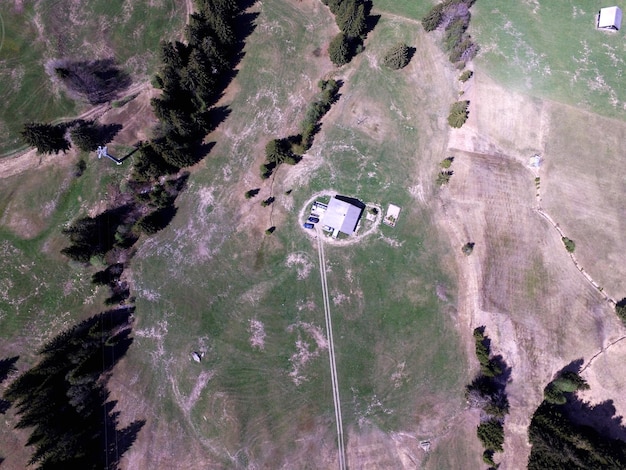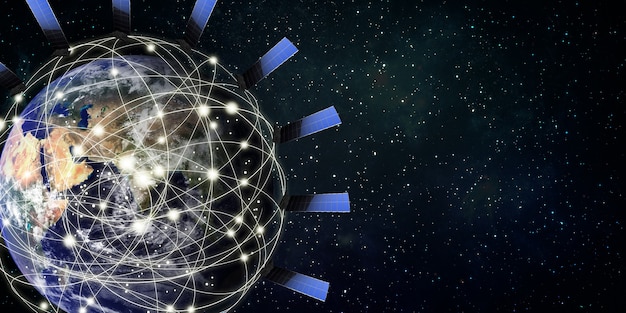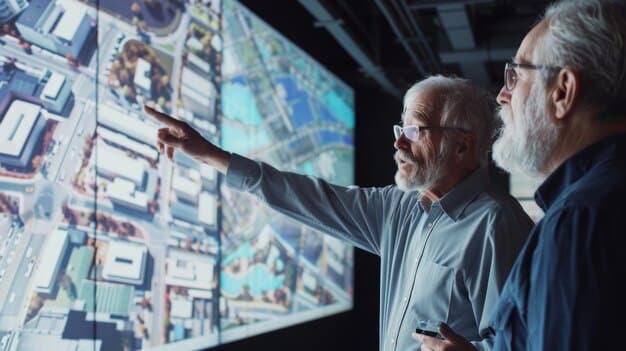Space-Based Surveillance: Enhancing US Intelligence with Satellites

Space-based surveillance is undergoing a revolution with new satellite technology, significantly enhancing US intelligence gathering capabilities through improved imagery, data processing, and real-time monitoring.
The landscape of US intelligence gathering is rapidly changing. Advanced satellite technology is at the forefront, promising unprecedented capabilities in space-based surveillance: How Will New Satellite Technology Enhance US Intelligence Gathering?
The Evolution of Space-Based Surveillance
Space-based surveillance has evolved dramatically, transforming from basic observation to a sophisticated, multi-layered intelligence-gathering system. This evolution is driven by advancements in satellite technology and the increasing need for real-time, comprehensive global monitoring.
Early surveillance satellites provided limited capabilities, primarily focused on imagery intelligence. Today’s satellites offer a wide range of sensors, including radar, infrared, and hyperspectral imaging, enabling them to collect diverse types of data under various weather conditions and at different times of day.
Historical Context
The initial forays into space-based surveillance were driven by Cold War tensions, with the US and Soviet Union racing to gain strategic advantages. The launch of Sputnik in 1957 spurred the US to accelerate its satellite programs, leading to the development of the Corona program, the first operational reconnaissance satellite system.
Modern Advancements
Modern advancements in satellite technology have revolutionized space-based surveillance. These advancements include improved sensor resolution, enhanced data processing capabilities, and the deployment of satellite constellations, which provide continuous global coverage.
- Enhanced Resolution: State-of-the-art imaging sensors can now capture images with incredibly high resolution, allowing for detailed analysis of ground-based objects and activities.
- Data Processing: Advanced algorithms and machine learning techniques enable the rapid processing and analysis of vast amounts of data collected by surveillance satellites.
- Constellations: Satellite constellations, such as those operated by Planet Labs and BlackSky, provide frequent and comprehensive coverage of the Earth’s surface.
The advancements in space-based surveillance technology have fundamentally changed the way intelligence is gathered and analyzed, providing policymakers and military leaders with timely and accurate information.

Key Technologies Driving Surveillance Capabilities
Several key technologies are driving the enhanced capabilities of space-based surveillance. These technologies include advanced imaging systems, improved data processing techniques, and the growing use of artificial intelligence.
Advanced imaging systems, such as synthetic aperture radar (SAR) and hyperspectral imaging, enable satellites to collect detailed information about the Earth’s surface. Improved data processing techniques allow for the rapid analysis of this data, while artificial intelligence (AI) is being used to automate the detection of anomalies and patterns.
Synthetic Aperture Radar (SAR)
SAR is a type of radar that can create high-resolution images of the Earth’s surface, even in cloudy or nighttime conditions. SAR satellites emit radar signals that bounce off the Earth’s surface, and the reflected signals are then processed to create an image. This technology is particularly useful for monitoring areas that are frequently obscured by clouds or darkness.
Hyperspectral Imaging
Hyperspectral imaging captures images across a wide range of the electromagnetic spectrum, providing detailed information about the composition of materials on the Earth’s surface. This technology can be used to identify specific types of vegetation, minerals, and other materials, making it valuable for environmental monitoring and resource management.
These technologies are revolutionizing space-based surveillance by providing more detailed and timely information to intelligence analysts and policymakers.
The Role of Commercial Satellite Providers
Commercial satellite providers are playing an increasingly important role in space-based surveillance. These companies operate large constellations of satellites and sell imagery and data to governments, businesses, and other organizations.
The rise of commercial satellite providers has increased the availability of space-based imagery and data, making it easier for organizations to monitor activities around the world. These providers offer a range of services, including high-resolution imagery, data analytics, and custom monitoring solutions.
Benefits of Commercial Satellite Imagery
Commercial satellite imagery offers several benefits over traditional government-owned satellite systems. These benefits include:
- Lower Cost: Commercial satellite imagery is often less expensive than government-owned imagery, making it more accessible to a wider range of users.
- Greater Availability: Commercial satellite providers operate large constellations of satellites, providing frequent and comprehensive coverage of the Earth’s surface.
- Faster Delivery: Commercial satellite imagery can often be delivered more quickly than government-owned imagery, enabling users to respond rapidly to changing situations.
Challenges and Concerns
The increasing reliance on commercial satellite providers also raises some challenges and concerns. These include:
The potential for foreign governments to access sensitive information through commercial satellite providers, along with the need to ensure that commercial satellite providers adhere to ethical and legal standards.

Impact on US Intelligence Gathering
The advancements in space-based surveillance technology are having a significant impact on US intelligence gathering. These advancements are providing intelligence analysts with more detailed and timely information, enabling them to better understand global events and trends.
Space-based surveillance is being used to monitor a wide range of activities, including military movements, terrorist activities, and environmental changes. This information is then used to inform policy decisions and protect national security.
Enhanced Situational Awareness
Space-based surveillance provides enhanced situational awareness by giving policymakers and military leaders a comprehensive view of events around the world. This awareness enables them to make more informed decisions and respond more effectively to emerging threats.
Improved Threat Detection
Space-based surveillance is also improving threat detection by enabling intelligence analysts to identify potential threats before they materialize. By monitoring activities around the world, analysts can detect patterns of behavior that may indicate an imminent attack or other hostile action.
Space-based surveillance is enabling the US intelligence community to better understand global events and trends, and to more effectively protect national security.
Ethical and Legal Considerations
The use of space-based surveillance raises several ethical and legal considerations, particularly related to privacy, transparency, and international law. As surveillance technology becomes more sophisticated, it is important to address these considerations to ensure that surveillance activities are conducted in a responsible and ethical manner.
Privacy concerns arise from the ability of surveillance satellites to collect detailed information about individuals and their activities. Transparency concerns relate to the need for governments to be open about their surveillance activities and to provide mechanisms for oversight and accountability. International law considerations include the need to ensure that space-based surveillance activities comply with the Outer Space Treaty and other relevant international agreements.
Balancing Security and Privacy
One of the key challenges in regulating space-based surveillance is balancing the need for security with the right to privacy. Governments have a legitimate interest in using surveillance to protect national security and prevent crime, but they must also ensure that surveillance activities are conducted in a way that respects individual privacy rights.
International Cooperation
International cooperation is essential to addressing the ethical and legal challenges of space-based surveillance. By working together, countries can develop common standards and norms for surveillance activities, ensuring that they are conducted in a responsible and ethical manner.
Addressing these ethical and legal considerations is essential to ensuring that space-based surveillance is used in a way that benefits society as a whole.
The Future of Space-Based Surveillance
The future of space-based surveillance is likely to be shaped by continued advancements in satellite technology, the increasing use of artificial intelligence, and the growing role of commercial satellite providers.
Future surveillance satellites will likely be smaller, more powerful, and more versatile than current satellites. They will also be equipped with advanced sensors and data processing capabilities, enabling them to collect and analyze even more data.
AI and Automation
Artificial intelligence (AI) and automation are likely to play an increasingly important role in space-based surveillance. AI can be used to automate the detection of anomalies and patterns in satellite imagery, freeing up human analysts to focus on more complex tasks.
Small Satellite Constellations
Small satellite constellations are becoming increasingly popular for space-based surveillance. These constellations consist of large numbers of small, low-cost satellites that can provide frequent and comprehensive coverage of the Earth’s surface.
The future of space-based surveillance: How Will New Satellite Technology Enhance US Intelligence Gathering? promises to bring even more advanced capabilities and challenges, requiring careful consideration of ethical, legal, and security implications.
| Key Point | Brief Description |
|---|---|
| 🛰️ Satellite Evolution | From basic observation to advanced, multi-layered surveillance systems. |
| 🔬 Key Technologies | SAR, hyperspectral imaging enhance data collection under any condition. |
| 🏢 Commercial Role | Commercial providers increase imagery availability but raise ethical concerns. |
| 🤖 AI Integration | AI automates analysis, improving efficiency and threat detection. |
FAQ
▼
Space-based surveillance involves using satellites equipped with sensors to monitor activities and gather intelligence on Earth. These satellites capture images, collect data, and track movements to provide critical information for various purposes.
▼
New satellite tech offers higher resolution imagery, more frequent coverage, and advanced data processing capabilities, which allows for more accurate and timely intelligence gathering. This leads to better situational awareness and quicker response times.
▼
Ethical concerns include privacy violations, potential misuse of data, and the impact on international relations. Balancing the need for security with individual rights is a key challenge in regulating space-based surveillance.
▼
Key commercial players include companies like Planet Labs, BlackSky, and Maxar Technologies. These companies operate large constellations of satellites and sell imagery and data to governments, businesses, and other organizations.
▼
The future of involves more advanced sensors, increased automation through AI, and a greater reliance on small satellite constellations. These advancements will enable more comprehensive and timely intelligence gathering capabilities.
Conclusion
In conclusion, the rapid advancements in satellite technology are revolutionizing US intelligence gathering, providing unprecedented capabilities for monitoring global events and trends. However, it is crucial to address the ethical and legal considerations associated with space-based surveillance to ensure that it is used responsibly and effectively in safeguarding national security.





